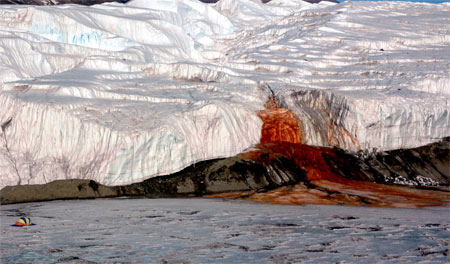Ancient microbesUnique community of bacteria found beneath Antarctic glacierPosted May 1, 2009
A cold, dark and oxygen-poor reservoir of water chemically similar to seawater seems an unlikely place to find a functioning ecosystem, particularly one trapped under an inland glacier in Antarctica. But samples collected from such an environment turned up an unusual microbial community, according to a recent study published in the journal Science. “When I started running the chemical analysis on it, there was no oxygen,” said Jill Mikucki, a researcher at Dartmouth College and lead author of the study. “That was when this got really interesting; it was a real 'eureka' moment.” More Information
Mikucki and colleagues collected and analyzed briny liquid originating from below the Taylor Glacier, an outlet glacier of the East Antarctic Ice Sheet located in the relatively ice-free McMurdo Dry Valleys of Antarctica. The researchers believe that, lacking enough light to make food through photosynthesis, the microbes have adapted over the past 1.5 million years to manipulate sulfur and iron compounds to survive. The ecosystem — because it has been isolated for so long in extreme conditions — could explain how life might exist on other planets and serve as a model for how life can exist under ice, said John Priscu, a co-author of the study and a professor in the Department of Land Resources and Environmental Sciences at Montana State University. The researchers discovered the bacteria while investigating Blood Falls The scientists believe the pool is less than five kilometers across. They said it is likely the remnant of an ancient ocean that was trapped when the floor of the Valleys arose more than 1.5 million years ago. The pool was eventually capped by the flow of the Taylor Glacier over Lake Bonney. Genetic analysis of the bacteria back up the theory: “The majority of these organisms are from marine lineages,” Mikucki said. In other words, the microorganisms are more similar to those found in an ocean than on land, but capable of surviving without the food and light sources available in the open ocean. The briny pond “is a unique sort of time capsule from a period in Earth’s history,” Mikucki said. “I don’t know of another environment quite like this on Earth.”
|



For USAP Participants |
For The Public |
For Researchers and EducatorsContact UsU.S. National Science FoundationOffice of Polar Programs Geosciences Directorate 2415 Eisenhower Avenue, Suite W7100 Alexandria, VA 22314 Sign up for the NSF Office of Polar Programs newsletter and events. Feedback Form |


